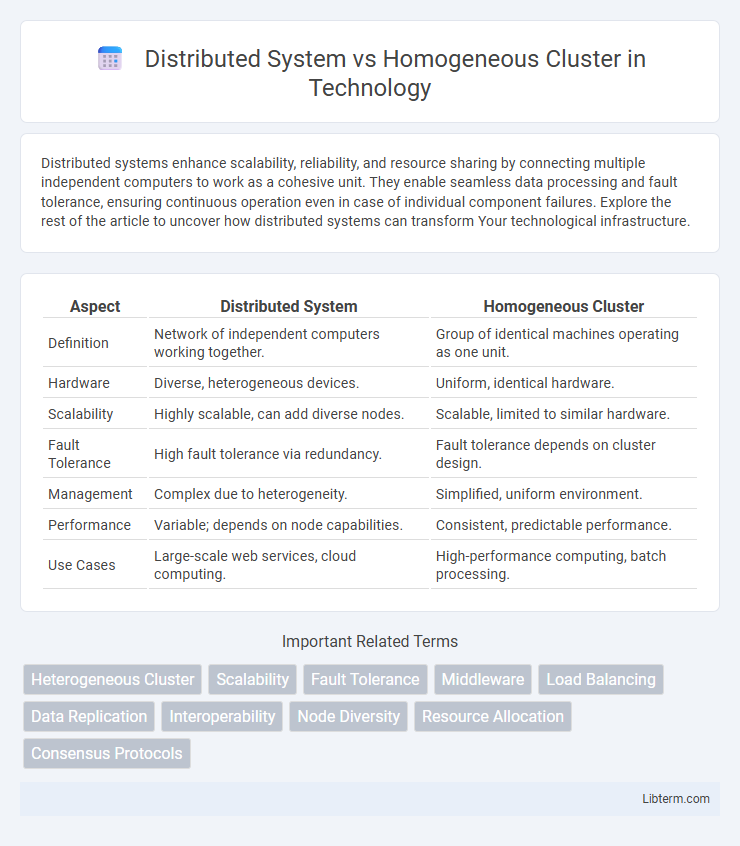Distributed systems enhance scalability, reliability, and resource sharing by connecting multiple independent computers to work as a cohesive unit. They enable seamless data processing and fault tolerance, ensuring continuous operation even in case of individual component failures. Explore the rest of the article to uncover how distributed systems can transform Your technological infrastructure.
Table of Comparison
| Aspect | Distributed System | Homogeneous Cluster |
|---|---|---|
| Definition | Network of independent computers working together. | Group of identical machines operating as one unit. |
| Hardware | Diverse, heterogeneous devices. | Uniform, identical hardware. |
| Scalability | Highly scalable, can add diverse nodes. | Scalable, limited to similar hardware. |
| Fault Tolerance | High fault tolerance via redundancy. | Fault tolerance depends on cluster design. |
| Management | Complex due to heterogeneity. | Simplified, uniform environment. |
| Performance | Variable; depends on node capabilities. | Consistent, predictable performance. |
| Use Cases | Large-scale web services, cloud computing. | High-performance computing, batch processing. |
Introduction to Distributed Systems and Homogeneous Clusters
Distributed systems consist of multiple independent computers working together to achieve a common goal, enhancing scalability and fault tolerance. Homogeneous clusters are a type of distributed system where all nodes share identical hardware and software configurations, simplifying management and workload distribution. Understanding the fundamental architecture of these systems aids in optimizing performance, reliability, and resource utilization.
Core Definitions: What Are Distributed Systems?
Distributed systems consist of multiple independent computers working together to achieve a common goal by communicating and coordinating over a network. Each node in a distributed system can have different hardware and operating systems, providing scalability and fault tolerance. In contrast, a homogeneous cluster is a set of identical machines connected to perform parallel processing, emphasizing uniformity and simplified management.
Understanding Homogeneous Clusters
Homogeneous clusters consist of identical or similar hardware components and operating systems, enabling seamless resource sharing and simplified management. They enhance fault tolerance and load balancing through consistent performance metrics across all nodes. This uniformity facilitates efficient parallel processing and scalability within distributed system architectures.
Architecture Comparison: Distributed vs Homogeneous Clusters
Distributed systems comprise multiple independent nodes that collaborate over a network, providing fault tolerance, scalability, and resource diversity. Homogeneous clusters consist of identical nodes tightly coupled to function as a single system, offering high performance and simplified management. Architecture comparison reveals distributed systems excel in geographic distribution and fault isolation, while homogeneous clusters deliver optimized resource utilization and uniform hardware environments.
Performance Characteristics and Scalability
Distributed systems leverage multiple independent nodes that communicate over a network, offering high fault tolerance and horizontal scalability by adding more machines. Homogeneous clusters consist of identical hardware and software nodes connected in a local environment, providing consistent performance with low latency and simplified management. While homogeneous clusters excel in predictable workloads with near-linear scalability, distributed systems better handle diverse, large-scale applications requiring fault tolerance and geographic distribution.
Fault Tolerance and Reliability Differences
Distributed systems enhance fault tolerance by replicating data and services across multiple heterogeneous nodes, minimizing single points of failure and enabling continuous operation despite individual node failures. Homogeneous clusters rely on identical hardware and software environments, which simplify fault detection and recovery processes but may present uniform vulnerabilities affecting all nodes simultaneously. The diverse configuration and asynchronous communication in distributed systems offer superior reliability through redundancy and dynamic load balancing compared to the tightly-coupled, uniform architecture of homogeneous clusters.
Resource Management in Both Approaches
Resource management in distributed systems involves coordinating heterogeneous resources across multiple nodes, optimizing load balancing and fault tolerance through decentralized control. Homogeneous clusters leverage uniform hardware and software environments, enabling streamlined resource allocation and simplified scheduling algorithms due to consistent node capabilities. While distributed systems prioritize scalability and flexibility with diverse resources, homogeneous clusters focus on maximizing efficiency and predictability in resource utilization.
Use Cases: When to Choose Distributed or Homogeneous
Distributed systems are ideal for large-scale applications requiring fault tolerance, scalability, and geographic data distribution, such as global e-commerce platforms and cloud services. Homogeneous clusters suit high-performance computing tasks with consistent hardware needs, like scientific simulations and batch processing. Choosing between the two depends on workload variability, fault tolerance requirements, and the extent of resource scaling needed.
Security Considerations in Both Models
Distributed systems require robust encryption and authentication protocols to secure data across disparate nodes, mitigating risks from diverse attack surfaces and network vulnerabilities. Homogeneous clusters benefit from uniform hardware and software configurations, simplifying patch management and intrusion detection but remain susceptible to single points of failure and insider threats. Both models demand comprehensive access controls and continuous monitoring to address security challenges inherent in their architectural differences.
Future Trends in System Architecture
Future trends in system architecture emphasize distributed systems leveraging edge computing and blockchain to enhance scalability and fault tolerance, transcending the limitations of homogeneous clusters. Advances in network virtualization and AI-driven resource management facilitate seamless integration across heterogeneous nodes, promoting adaptive, resilient infrastructures. Embracing software-defined networking and container orchestration technologies, distributed systems are poised to deliver unprecedented flexibility and efficiency compared to traditional homogeneous cluster configurations.
Distributed System Infographic

 libterm.com
libterm.com